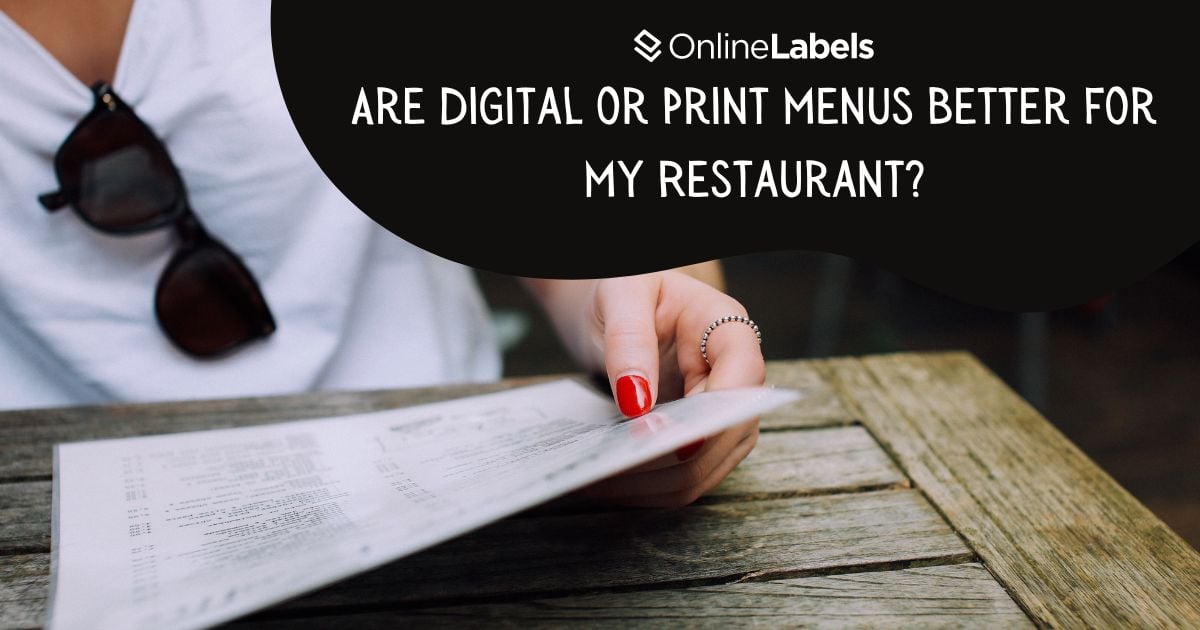Are Digital or Print Menus Better for My Restaurant?

As restaurant marketing trends continue to advance, the debate over whether to use digital or printed menus remains persistent. The number of takeout orders and deliveries is crucial when analyzing which option to choose. In this article, we'll explore how different menu solutions can help you make informed decisions for your business.
Digital vs Printed Menus for Restaurants
Printed Menus
Most customers expect printed menus when they enter a restaurant. These tangible menus offer several benefits over digital menus.
Some of the benefits that should be considered include:
- Customer-friendly: physical menus are universally recognized and easy to understand. They're accessible to different age groups and agnostic to technical know-how.
- Better portrayal of restaurant concept: the design of physical menus can emphasize the most essential dishes from the restaurants, promotions, and the restaurant's history or culture.
- Tangibility and high-end feel: one of the advantages of physical menus is their physicality. A tactile experience can enhance brand perception and help the client better connect with the restaurant.
A written menu has advantages; however, when generating updates and changing items, people must consider the different setbacks of physical menus.
The critical setbacks to consider include the following:
- Lacking physical durability: menus can break, wrinkle, get wet, or even burn, making it a liability for the company to change the menus constantly when incidents happen.
- Risk of theft: a physical menu can be easily stolen, adding additional costs if it needs to be replaced.
- Limited flexibility: adding new items, adjusting prices, and removing dishes are much more time-consuming and costly than physical menus.
Digital Menus
Digital menus have become a game-changer for restaurants. As restaurants look to enhance customer engagement and improve operations, digital menus are revolutionizing how clients order, eat, and enjoy their favorite meals.
- Faster decision-making and ordering: restaurants tend to get busy. With many tables and orders to take, QR codes linking to a digital menu can help patrons browse the menu and even order food immediately.
- Opportunities for takeout, delivery, and pick-up: digital menus allow customers to order food from their homes for delivery or takeout easily.
- Enhanced order placement in kitchen facilities: when an order is placed in the kitchen, it can get mixed, the waiters' handwriting can make the order unreadable, and paper orders can get dirty or wet. A virtual menu can help make the orders more legible and accessible.
Although virtual menus can be an excellent advantage for handling orders, there are a few problems to consider.
- Initial setup costs: using virtual menus can involve significant upfront costs, such as developing and aligning a custom app with the restaurant's existing technology. Other expenses include software updates, technical support, maintenance, etc.
- Potential technical issues: virtual menus rely on functional devices and internet connections. Technical glitches, poor internet connections, or device malfunctions can prevent customers from accessing the menu, leading to frustration and order delays.
- Failed personal experience: virtual menus can prevent the restaurant from having a personal experience with the clients. Some customers appreciate the interaction of the waiters to ask questions and have information about the menu.
How to Decide Between Print and Digital Menus
Choosing between print and digital menus is a critical decision that can impact your customers' experience in a restaurant. To determine which option is best for your business, consider the following factors:
The Scale of Operations
- Small businesses and startups: if your business is just starting out or operating on a smaller scale, printed menus might be the more practical option. They offer a good solution without significant upfront investment in technology.
- Larger enterprises: for businesses with significant operations or multiple locations, digital menus can offer greater flexibility when customers place orders. This would allow more accessible updates, dynamic content, and consistent changes across all placements.
Frequency of Menu Changes
- Static or rarely changing: if you expect your menu to remain constant over a long period, a printed menu is likely a more cost-effective option.
- Dynamic or frequently changing information: if your menu needs regular updates, such as seasonal promotions, limited editions, or regular changes, digital menus can save time and money.
Suggestion: if your menu needs price changes, cover them with labels that cover the content underneath entirely. Our block-out labels feature an opaque backing and are writable with pencil, pen, and Sharpie.
Customer Interaction and Engagement
Face-to-face personalized experience: for businesses that thrive on creating a personalized, tactile customer experience, printed menus add a tangible element that digital labels cannot replicate. High-quality materials, finishes, and designs can make your menu stand out and convey a sense of craftsmanship.
Tech-savvy, digitally engaged customers: digital experiences are fun and creative. If your target audience is comfortable with technology and appreciates innovation, digital menus can enhance their interaction with your brand.
Suggestion: features like QR codes and personalized digital content can add value and engage customers in a way that static printed menus cannot. Try printing your QR codes on labels and sticking them to your dining tables so customers can see them immediately. We provide a selection of aggressive adhesives, weatherproof labels, and a free QR code generator to help you get started.
Tips for a Hybrid Approach
Creating a hybrid menu strategy that combines printed and virtual menus can offer the best of both worlds. Here are some tips for effectively integrating both methods into your business.
- Analyze the strengths of each format: printed menus offer a tangible connection, while virtual menus can be easily updated. A way to combine these types is to offer a physical menu for customers and provide a virtual menu for drinks and desserts.
- Ensure entertainment during wait time: several food businesses have significant wait times between orders, so providing virtual entertainment can help customers stay happy and distracted during wait times. For this part, providing a physical menu for orders and virtual entertainment can give your business the best of both methods.
- Marketing and social media integration: use a QR code label to link to your restaurant's social media. This can keep customers informed about specials and deals and allow them to see photos of dishes.
Providing stickers or labels on your social media and restaurant pages is an excellent way to showcase your restaurant's unique features. For more information, we provide a guide on ways to use labels and stickers in food businesses, including a section on social media.
Choosing the Right Menu Strategy
Deciding between printed and digital menus ultimately depends on the unique needs of your restaurant and customer base. While printed menus offer a tangible, familiar experience that appeals to a wide range of customers, digital menus provide order flexibility and create customer engagement. By carefully evaluating the strengths and limitations of each or considering a hybrid approach, you can make a menu strategy that would satisfy your operational needs and enhance the overall dining experience.
Need pre-printed labels for your restaurant? Check out our selection of restaurant labels.



